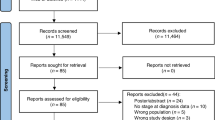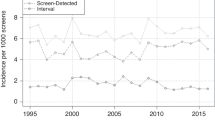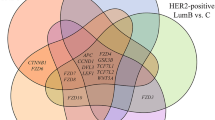Abstract
We investigated breast cancer incidence in migrants in the Netherlands in 1988–1998. The standardised incidence ratio for breast cancer in Northwest-Netherlands was statistically significantly reduced for women born in Surinam (0.56), Turkey (0.29) and Morocco (0.22). The proportion of women with advanced stages (III and IV) did not differ significantly between migrants and women born in the Netherlands.
Similar content being viewed by others
Main
Breast cancer, the commonest cancer in women world-wide, has a particularly low incidence in Central- and East-Africa, as well as in East-Asia (Ferlay et al, 1998). In contrast, most Western countries have a high incidence, while the Netherlands is among the highest in the world (Van der Sanden et al, 1995). Differences in breast cancer incidence have been observed in the United States among different ethnic groups (Ziegler et al, 1993; Brinton et al, 1997). Studies of Japanese migrants to Hawaii have shown that breast cancer incidence adjusts to the incidence in the new homeland within one or two generations pointing to life style and environmental factors in aetiology (McPherson et al, 2000).
In recent decades, immigration has changed the composition of the population of the Netherlands, especially in the large cities, so that in 2002, 10% of its population and even 28% of the population of Amsterdam was foreign-born (StatLine. Statistics Netherlands). Migrants originate primarily from the former Dutch colonies (Indonesia (former name: Dutch East-Indies), Surinam and the Netherlands Antilles), Turkey and Morocco.
We have investigated differences in breast cancer incidence between migrants and women born in the Netherlands.
Materials and methods
Cancer registry data
Our data have come from the cancer registries of the Comprehensive Cancer Centre Amsterdam (CCCA) and the Comprehensive Cancer Centre West (CCCW), both part of the nation-wide Netherlands Cancer Registry (Van der Sanden et al, 1995). Information is extracted by registration clerks from medical records in all regional hospitals. If available in the hospital, the country of birth is routinely collected. Because the country of birth is unknown in many hospitals, only cases with residence in The Hague and the province of North-Holland have been included in this study. For women who participated in the breast cancer screening and who had agreed to record linkage of screening data to the cancer registry, the country of birth in the cancer registry has been validated with the country of birth as available in the screening data. In case of discrepancy or missing data in the cancer registry, the country of birth as available in the screening data has been used.
Population data according to country of birth
Statistics Netherlands receives population data from municipal population registers via the computerised population network that operates since October 1994. Annual overviews (as of 1995) of the population according to age group, sex and country of birth (Turkey, Morocco, Surinam, the Netherlands Antilles and Indonesia) for North-Holland and the city of The Hague have been used. For 1988–1994, estimations of Statistics Netherlands for 1992 and 1989–1994 (Surinam and the Netherlands Antilles only) have been used, with extrapolations for the remaining years. North-Holland and The Hague combined represent 18% of the total population of the country, but approximately one-third of the migrant population of the Netherlands.
Statistical methods
Using the population data by 5-year age group and country of birth and age-specific breast cancer incidence rates from the Netherlands Cancer Registry for 1989–1998, expected numbers of breast cancer (E) for North-Holland and The Hague were calculated for women born in Turkey, Morocco, Surinam, the Netherlands Antilles and Indonesia, as well as for the total female population. The observed numbers (O) of breast cancer were adjusted for cases with unknown country of birth, assuming that the distribution according to country of birth for unknown cases was equal to the distribution of cases with known country of birth. Standardised incidence ratios (SIRs) were calculated as the ratio between the adjusted observed and expected numbers. Exact 95% confidence intervals (CI) based on the Poisson distribution of the adjusted O were calculated using STATA 7.0 (StataCorp. Stata Statistical Software: Release 7.0. College Station, TX: Stata Corporation).
Results
Breast cancer incidence
In 1988–1998, a total of 16 499 invasive breast cancers were diagnosed in North-Holland (28% resident in Amsterdam) and 3517 in The Hague (Table 1). In total, 83% of the women were born in the Netherlands. The percentage of foreign-born was 12% in The Hague, 13% in Amsterdam and 6% in North-Holland (excluding Amsterdam). The country of birth was unknown for 8% of the cases.
Figure 1 shows that the overall SIR in North-Holland and The Hague was similar to the national average (SIR 0.98; 95% confidence interval (CI): 0.97, 1.00), slightly higher in women below the age of 50 (SIR 1.01) than in women of 50 years or older (SIR 0.97). For women born in Indonesia the SIR was similar to the national average (SIR for all ages: 0.99, 95% CI: 0.92, 1.08), but for women below the age of 50 the rate was lower (SIR 0.83, 95% CI: 0.67, 1.01). For women born in the Netherlands Antilles, the SIR was 0.84 (95% CI: 0.65, 1.08) and for women born in Surinam a statistically significantly decreased rate of 0.56 (95% CI: 0.49, 0.64) was found. Very low rates were observed for women born in Turkey (SIR 0.29, 95% CI: 0.21, 0.39) and Morocco (SIR 0.22, 95% CI: 0.15, 0.32). In women born in Turkey or Morocco, the SIRs were lower among those 50 years or older than among younger women below the age of 50 (0.23 vs 0.35 and 0.10 vs 0.33, respectively).
Stage distribution
Table 1shows the distribution by TNM-stage and country of birth for women with breast cancer in North-Holland. Cases of unknown stage (2% of all cases), mainly due to unknown tumour size, were considered as localised. In all, 85% of all cancers were localised (stage I or II), and 15% had locally advanced disease or distant metastases (stages III or IV). The proportion of advanced stages ranged from 13% for women born in Turkey to 22% for those born in the Netherlands Antilles. A logistic regression analysis showed that, corrected for age group, the proportion with advanced disease did not differ significantly between the foreign-born and the native-born women (15%).
Discussion
The risk of breast cancer among women resident in the Netherlands but born in Surinam, Turkey and Morocco appears to be still close to that in their country of origin. Although no national incidence data are available for these countries, estimates for the year 1990 show incidence rates that were 48, 29 and 35%, respectively, of the Netherlands rate (Parkin et al, 1999). In the Netherlands Antilles, the incidence was 60.9 per 100 000 women (European standardised rate) in 1987–1991, about 60% of the Netherlands rate during that period (Schakenraad et al, 1995). The somewhat higher breast cancer risk of women born in the Netherlands Antilles resident in the Netherlands is probably due to the selective migration of higher educated women. Until recently, further education was one of the main motives for women to migrate to the Netherlands.
The low incidence in women born in Turkey and Morocco can probably be attributed to differences in breast cancer risk factors in comparison to native women, especially in relation to reproduction. Compared to native women, women born in Turkey and Morocco have more children and have their first child at an earlier age. Because these women mainly came to the Netherlands as a partner of (male) migrant workers, the percentage of unmarried women without children is negligible (StatLine. Statistics Netherlands). Reproductive factors in the Surinam-born are intermediate between those in native women and those born in Turkey or Morocco, so their intermediate incidence is not surprising. The smallest differences in reproductive factors from native women occur in women born in the Netherlands Antilles and correspondingly their breast cancer risk is close to that in women of Dutch descent.
The higher incidence in younger (below age 50) than in older women born in Morocco or Turkey, is probably due to a change in risk factors in younger women, such as lower parity. The slightly lower risk for women below the age of 50 born in Indonesia (SIR 0.83) may reflect the fact that older women are mainly of Caucasian (Dutch) origin, while younger women, especially those born after the independence of Indonesia in 1949, are more often of ethnic Indonesian origin.
In conclusion, in Northwest-Netherlands, women born in Surinam, Turkey and Morocco have a significantly lower breast cancer risk than women born in the Netherlands. It will be of interest to examine the risk of second-generation migrants in the future.
Change history
16 November 2011
This paper was modified 12 months after initial publication to switch to Creative Commons licence terms, as noted at publication
References
Brinton LA, Benichou J, Gammon MD, Brogan DR, Coates R, Schoenberg JB (1997) Ethnicity and variation in breast cancer incidence. Int J Cancer 73: 349–355
Ferlay J, Parkin DM, Pisani P (1998) GLOBOCAN1: Cancer Incidence and Mortality Worldwide. CD-ROM of International Agency for Research on Cancer, World Health Organization. Lyon: IARC Press
McPherson K, Steel CM, Dixon JM (2000) Breast cancer – epidemiology, risk factors, and genetics. Br Med J 321: 624–628
Parkin DM, Pisani P, Ferlay J (1999) Estimates of the worldwide incidence of 25 major cancers in 1990. Int J Cancer 80: 827–841
Schakenraad J, Coronel C, Otter R (1995) Kankerincidentie in de Nederlandse Antillen 1982–1991. Groningen/Willemstad: Laboratorium voor de Volksgezondheid
StatLine. Statistics Netherlands. http://statline.cbs.nl/StatWeb/start.asp?lp=Search/Search
Van der Sanden GA, Coebergh JWW, Schouten LJ, Visser O, van Leeuwen FE (1995) Cancer incidence in the Netherlands in 1989 and 1990. First results of the nationwide Netherlands Cancer Registry. Eur J Cancer 31: 1822–1829
Ziegler RG, Hoover RN, Pike MC, Hildesheim A, Nomura AM, West DW, Wu-Williams AH, Kolonel LN, Horn-Ross PL, Rosenthal JF (1993) Migration patterns and breast cancer risk in Asian-American women. J Natl Cancer Inst 85: 1819–1827
Acknowledgements
We thank the registration clerks of the Comprehensive Cancer Centres Amsterdam and West for the collection of the incidence data.
Author information
Authors and Affiliations
Corresponding author
Rights and permissions
From twelve months after its original publication, this work is licensed under the Creative Commons Attribution-NonCommercial-Share Alike 3.0 Unported License. To view a copy of this license, visit http://creativecommons.org/licenses/by-nc-sa/3.0/
About this article
Cite this article
Visser, O., van der Kooy, K., van Peppen, A. et al. Breast cancer risk among first-generation migrants in the Netherlands. Br J Cancer 90, 2135–2137 (2004). https://doi.org/10.1038/sj.bjc.6601821
Received:
Revised:
Accepted:
Published:
Issue date:
DOI: https://doi.org/10.1038/sj.bjc.6601821
Keywords
This article is cited by
-
Mammographic Breast Density and Acculturation: Longitudinal Analysis in Chinese Immigrants
Journal of Immigrant and Minority Health (2021)
-
The Impact of Breast Cancer Knowledge and Attitudes on Screening and Early Detection Among an Immigrant Iranian Population in Southern California
Journal of Religion and Health (2014)
-
Cancer incidence and mortality of Surinamese migrants in the Netherlands: in-between Surinamese and Dutch levels?
Cancer Causes & Control (2013)
-
Differences in the cancer burden among foreign-born and US-born Arab Americans living in metropolitan Detroit
Cancer Causes & Control (2013)
-
Who is being referred to cancer genetic counseling? Characteristics of counselees and their referral
Journal of Community Genetics (2012)




